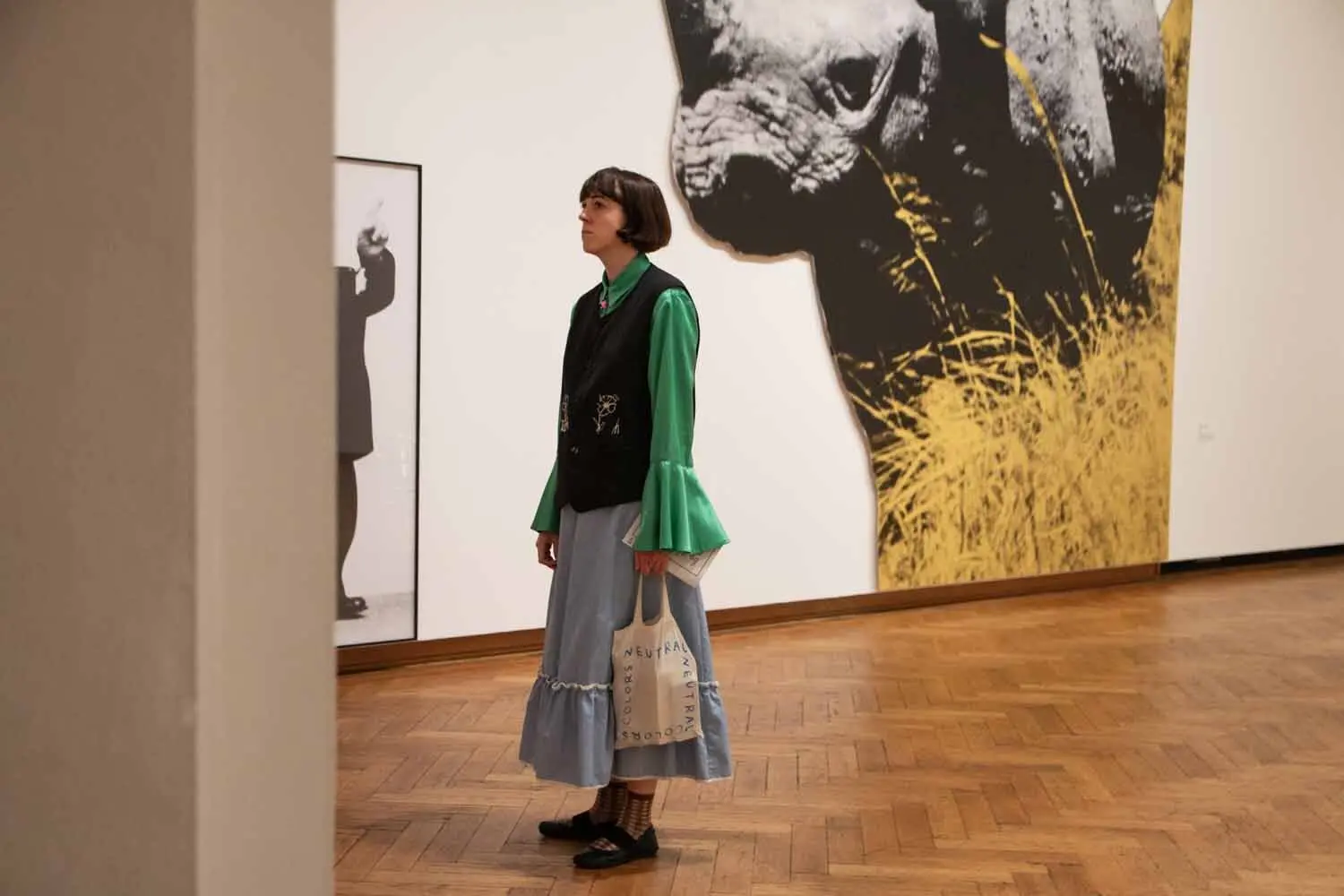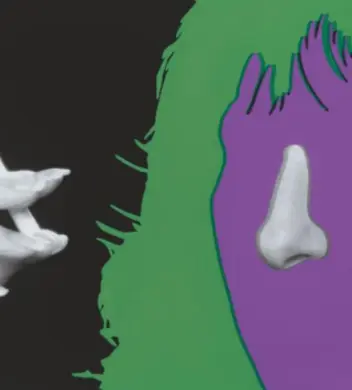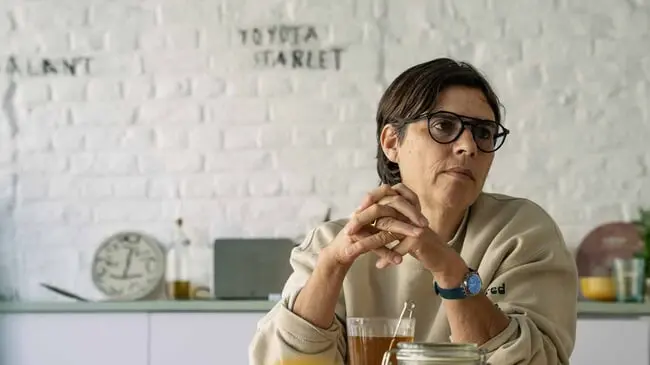Beauty in the Banal

John Baldessari turned mundane, everyday elements into stories that feel timeless, through wit and humour. At Bozar’s Parables, Fables, and Other Tall Tales exhibition, Antwerp-based photographer Sarah Stone tells us how she sees beauty in the ordinary. She sees photography as her visual diary, capturing the poetry of everyday life with colour and the charm of analogue. Her reflections remind us that art can be playful, reimagined and found in the simplest moments.
What were your first impressions of the exhibition?
I love how big the works are. I’d only seen Baldessari’s work on my laptop screen or in books, where everything feels small. In person, you see the monumentality of the work, which was surprising. I imagined collage work to be so small, but actually it’s not how I expected them to turn out in person; they become complete artworks themselves, and that’s really nice.
The exhibition doesn't dive too much into the sticker theme that he’s often associated with. I saw in the expo’s video how he became known for putting dots on people’s faces using cheap stickers from a craft shop - it became one of his trademarks. But here the focus shifts more to his other works, which are also interesting.
<img class="editorial-image-50-left" src="https://cdn.prod.website-files.com/61eebcc683107b99137f4423/68e79f7a0f0f931b9ad26a78_13.avif"/>
<img class="editorial-image-50-right" src="https://cdn.prod.website-files.com/61eebcc683107b99137f4423/68e79f780659e60a28a23a43_4.avif"/>
How did you experience the exhibition as a whole?
I found it very raw. The way that he uses words that keep popping up makes it so that you get to know John Baldessari by walking through the exhibition. I don’t feel like I have gotten to spend enough time with him, but I do get an insight into how his studio would have been and the way that he created art.
<img class="editorial-image-50-left" src="https://cdn.prod.website-files.com/61eebcc683107b99137f4423/68e79f789c543e2ea52c894f_3.avif"/>
<img class="editorial-image-50-right" src="https://cdn.prod.website-files.com/61eebcc683107b99137f4423/68e79f7754f65a98a4850cd2_2.avif"/>
You mentioned he inspired some of your work. How did you first discover Baldessari?
I first came across his work when I was studying fashion. We had to make these colour proposals for our collections, so I stumbled upon his way of combining old imagery with pops of colour. I really loved the fuse between vintage imagery and his take on colourful bursts. I then used this idea to create my colour cards - using old images and squares of colour collaged on top. He uses imagery in so many ways, and I find that very inspiring. I use my own images, but I’ve always been very fond of collage.
<img class="editorial-image" src="https://cdn.prod.website-files.com/61eebcc683107b99137f4423/68e79f7ae1087ff0120ce63f_14.avif"/>
Can you tell us more about your own practice?
I studied fashion in Amsterdam for four years, and it was incredible because it gave me my ‘handwriting’ as they would say. But after so many years, I wanted to dive more into the outside world because with fashion you’re very cooped up inside - stitching, making patterns and researching - and I just wanted to be outside. I started by taking my analogue camera around Amsterdam, especially in the quieter parts of the North. The world became like a playground, and that’s when I realised this is what I wanted to do. I was using an analogue camera that my father gave me, and I started to print the pictures. My friends motivated me to do it more often until I decided to jump into it and studied photography in Antwerp.
I feel very married to photography because of its purity. As much as I appreciate and respect digital photography, I don’t feel like myself with a digital camera - I feel disconnected. Analogue allows me to step away from what I created and wait without overthinking it because the image doesn’t exist yet.
<img class="editorial-image-50-left" src="https://cdn.prod.website-files.com/61eebcc683107b99137f4423/68e79f784522a7d2b2f9ef86_5.avif"/>
<img class="editorial-image-50-right" src="https://cdn.prod.website-files.com/61eebcc683107b99137f4423/68e79f799d6a380cdbb646b1_7.avif"/>
The exhibition highlights Baldessari’s playful storytelling. You've described your photography as a visual diary, so how do you find narrative in your art?
Narrative is tricky, but when you stay true to yourself, it will flow naturally. You can always stage it in a certain way, which is something we are taught in school for assignments. But when you step out of that, you shape your own story. For me, it comes from following my own life. I document, not myself, but the things that I am surrounded by and then I try to shed beauty on them. I feel so blessed in the way that I love beauty, and that I see beauty in things. And of course, it’s subjective, but I cannot imagine a life without seeing beauty.
I feel so blessed in the way that I love beauty, and that I see beauty in things
Thinking of Baldessari, it’s about taking the norm, the general, and just putting your magic wand on it. Photography always takes, you capture something that already exists - but then when you take something very simple and collage it, document it or add words to it - that’s when you create your own visual narrative. Here, Baldessari is taking elements and then he adds his own voice to them.
<img class="editorial-image-50-left" src="https://cdn.prod.website-files.com/61eebcc683107b99137f4423/68e79f79d0438206e1806d1f_6.avif"/>
<img class="editorial-image-50-right" src="https://cdn.prod.website-files.com/61eebcc683107b99137f4423/68e79f7b501c6dea53e61105_17.avif"/>
What elements of this exhibition would you capture in your own visual diary?
Definitely the banal details - the shirt, the shoe, the cup. I love his appreciation for the everyday and for strong cinematography. Film directors from the 1960s and 70s have also shaped my own work. I like that he uses pre-existing elements and puts his own stamp on them, because why create more images when there are so many out there? His work may have been made quite a long time ago, but you don’t feel it - it’s totally timeless. I also like that he uses very few words that form a lot of power. It’s very simple yet very smart. I love conceptual art, and when artists dare to make a joke out of their art, something Baldessari does so well.
I love conceptual art, and when artists dare to make a joke out of their art
<img class="editorial-image" src="https://cdn.prod.website-files.com/61eebcc683107b99137f4423/68e79f7c54f65a98a4850f2f_19.avif"/>
Are there any ideas you’ll be taking with you to your own practice after this visit?
Collages and mixing photography. Ripping apart photography and then glueing it back together in a different way. I would love to do that with my own work. I think it’s super fun because you destroy something you’ve been trying to perfect, and then you make it into a newer artwork and regenerate it. It’s a reminder that you don’t always have to create new images, yet you can create art endlessly. You can revisit your archive and experiment with other materials, add paint on top, scratch it, or disturb the perfect print. Sometimes we repeat the same formats and frames, so it’s nice to see an artist who dared to question that.
It’s a reminder that you don’t always have to create new images, yet you can create art endlessly
<div class="editorial-banner"> <div class=“editorial-credits”>@sarah.stone__<br><br/>Een revolver zonder vervolg, net als de volgende revolver. Notities on John Baldessari by Dirk Van Bastelaere is published by Het Balanseer/Bozar.<br><br>Sarah Stone will be releasing her book 99 COLLAGES at the end of this year, published by SO-RI.<br></div></div>
Different Class works with the interest of their community at heart.
Our work’s purpose is to foster a solid network for independent artists, those who love them, and those who want to support them. Become a member to contribute to the local Belgian art scene.






